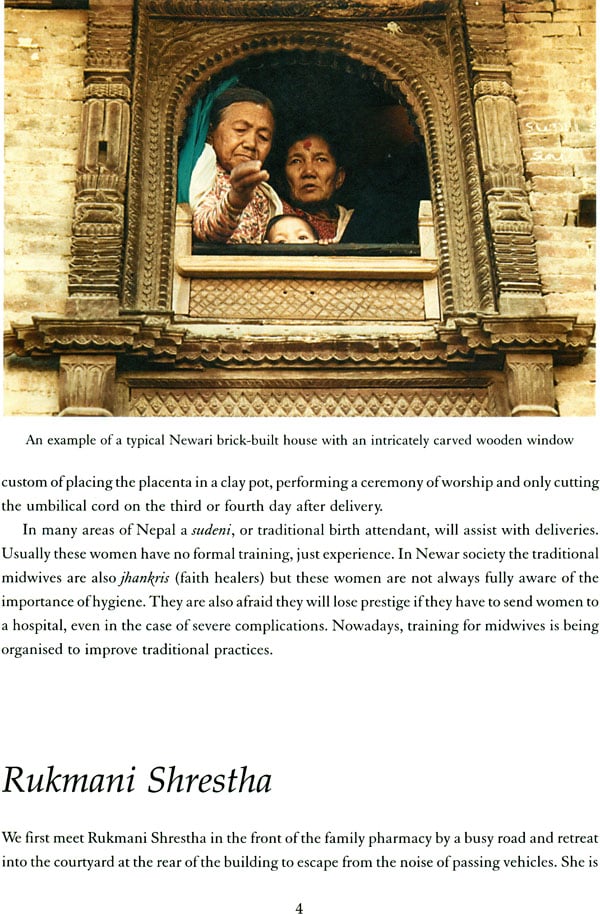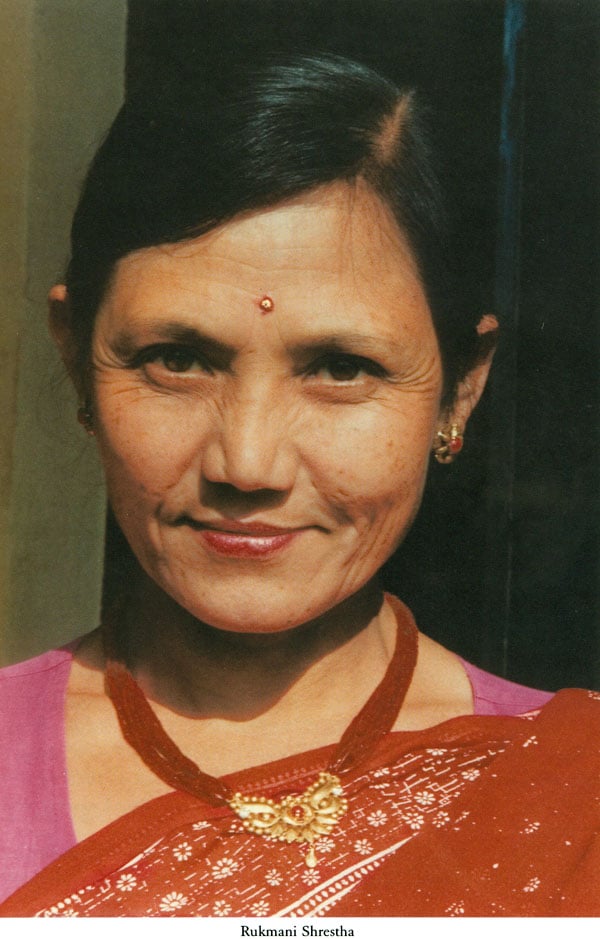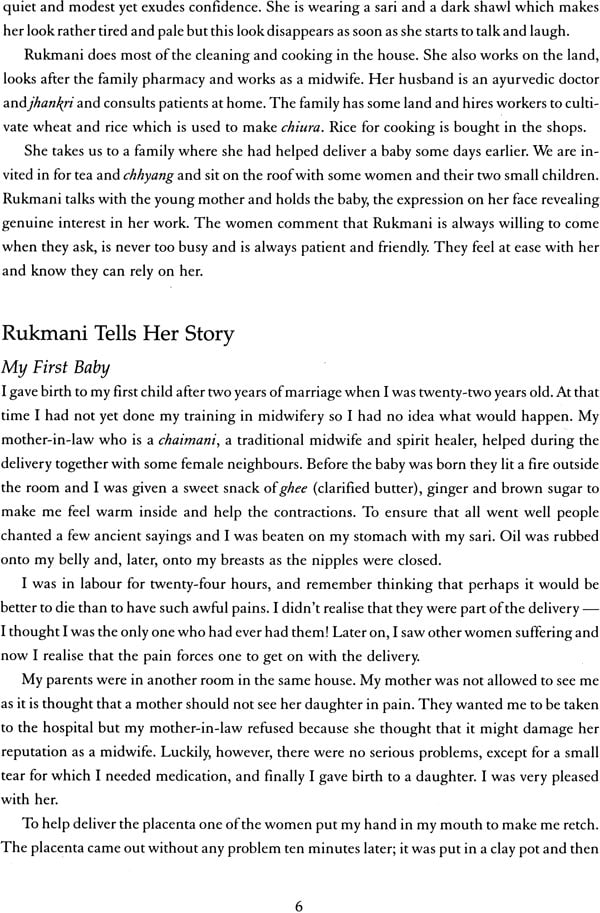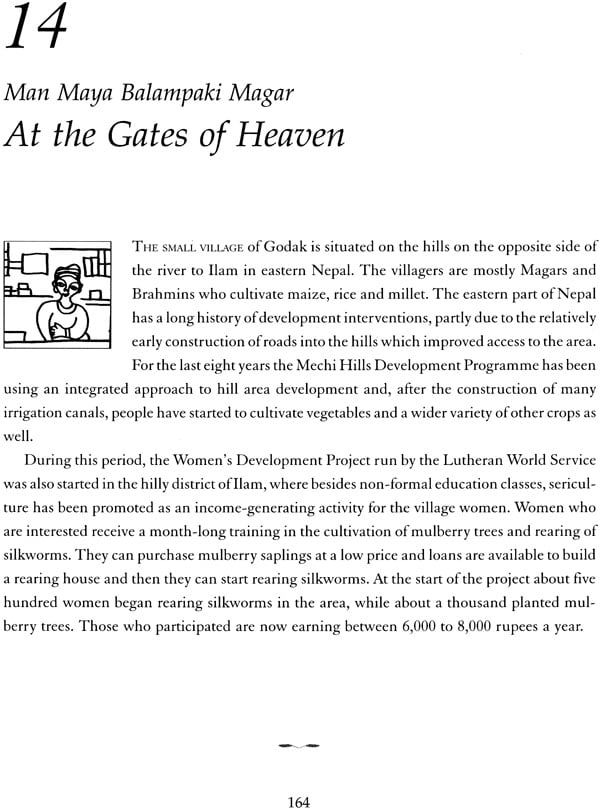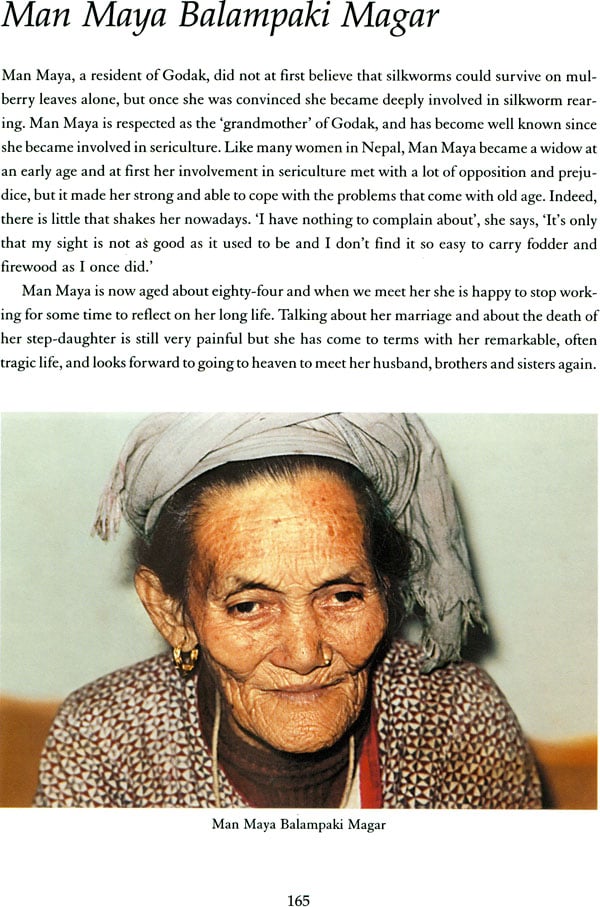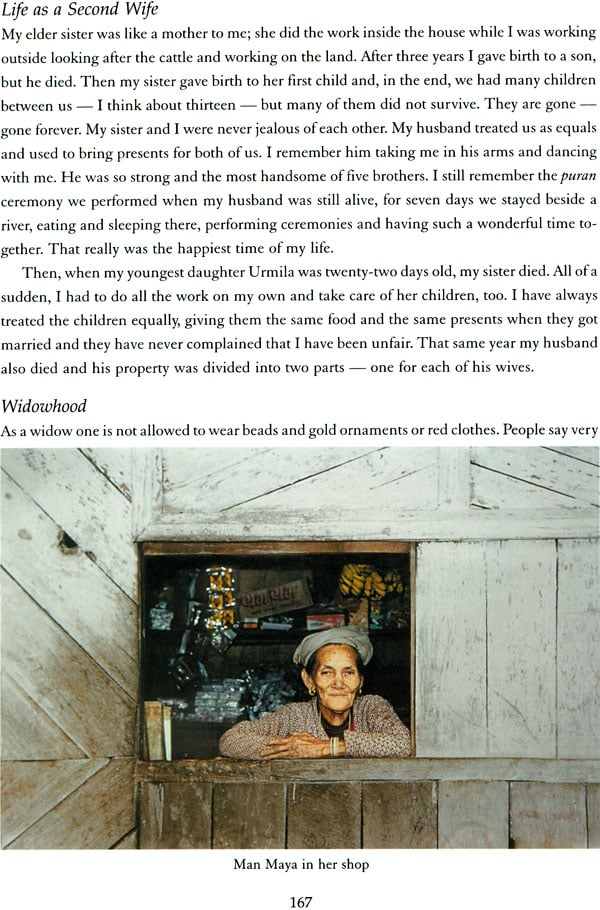
Bending Bamboo Changing Winds: Nepali Women Tell Their Life Stories
Book Specification
| Item Code: | IDI144 |
| Author: | Eva Kipp |
| Publisher: | Pilgrims Publishing Varanasi Delhi Kathmandu |
| Language: | English |
| Edition: | 2006 |
| ISBN: | 8177694510 |
| Pages: | 190 (Illustrated Throughout in Color with One Map) |
| Cover: | Paperback |
| Other Details | 7.1"X 9.9" |
| Weight | 640 gm |
Book Description
This book has been written with the purpose of gaining a greater understanding of the reality of Nepali women's life in different parts of the country, in varied socio-economic categories, and also, in most cases, how positive changes in their lives taken place.
Visiting the women and talking with them yielded a wealth of information and glimpse into their lives, thoughts, beliefs, concerns and pleasures- factors which rarely appear in statistics. The women showed remarkable resourcefulness in developing strategies to cope with conditions and situations that seem very difficult to outsiders. Nepal is a small, mountainous kingdom populated by a variety of ethnic groups of Aryan and Mongolian stock. The varied topography of high mountains, low plains and inaccessible valleys has restricted communications between the many indigenous groups and outsiders, so that ancient languages and dialects, as well as religious beliefs and customs, have been preserved and the differences across the country are vast.
For a Nepali woman the group into which she is born often determines the whole pattern of her life. Her position, status and freedom depends on the characteristics of her ethnic group. Women belonging to the Mongolian (Tibeto-Burman) groups like Sherpa, Gurung and Tamang generally have fewer restrictions that the women belonging to the Indo-Aryan groups such as Brahmin, Chhetri and Newar, where child marriage still exists and the position of a daughter-in-Law is still very unfavourable.
The religion of the Indo-Aryan groups in Hindu, and these groups are divided into caste. In medieval times the country used only indigenous labour to meet all its needs. In order to attain self-sufficiency, divisions were made in the society and tasks allocated to particular groups, known as castes. Castes are hereditary and the caste system is hierchial. Skills were handed down through generations. Skilled craftsman and artisans, such as blacksmiths, shoemakers and tailors, were given the lowest ranking in the hierarchy and regarded as 'untouchable'.
Despite the formal abolition of the caste system in 1963 and the diversification of trade and callings of people within the different castes, it has proved very difficult to shake off the age-old customs and legacy of the past Members of the higher castes tend to be more resistant to change than lower caste people who continue to face discrimination. The former system of marriage, restricted to one's own caste, is now breaking down in some parts of the country, as an increasing number of young people choose their own partners. More progressive families may accept a daughter-in-Law whom they have not selected themselves, even if she is from a different caste, but more traditional families may refuse, leaving the newly married couple to fend for themselves.
Back of the Book
This book is a garland of vivid life stories about Nepali women coming from unique socio- cultural contexts . In a nutshell, this is a unique book that begins to communicate the perspectives of Nepali women of life, family, religion, happiness, development, and it soon begins to fill the gap in women's studies in South Asia . The writers have fulfilled the purpose of the book as it was stated. They have opened a gate future studies on women, not only in Nepal but all over South Asia.
The stories in the book came directly from the hearts of women whose lives have not changed much.
The book proves with notable force and cogency that women are in better position to effect positive developments in their lives if they own money and property
The authors purpose was to gain a greater understanding of the reality of Nepali women's life in different parts of the country The authors have done a wonderful job in bringing these Nepali women clearly to life.
This is a book to treasure and re-read
Many changes influencing women have taken place in modern Nepalese society. Women's lives in the past, were directed solely by social and cultural norms, and though traditional customs still play an important role, many new opportunities are emerging. Women now have more access to education, improved services like water supply and health care, and they are traveling more. Projects focusing on methods to increase the earnings of women have also improved their quality of life, and provided alternate strategies for survival for both women and their families.
Listening to village women helped us to identify and understand the elements, which have contributed to positive changes families.
From their stories one learnt what the women thought about the different aspects of their lives and the changes that are talking place. Their stories further show how powerful and creative village women can be.
In compiling this book, women were chosen from varied ethnic groups and castes found in Nepal, and a further selection was made according to their specific lifestyles and activities. The authors paid personal visits to all the women, spending between a few days to a few weeks in discussions with in their homes.
The interviews and photographs revealed a wealth of information and a rare glimpse into the thoughts, beliefs, worries and pleasures of Nepali women today.
| Preface | vi | |
| Acknowledgements | vii | |
| Map of Nepal: Homes of the Women Interviewed | viii | |
| Introduction | ix | |
| 1 | Rukmani Shrestha: Devotion to Duty | 1 |
| Eva Kipp and Marieke van Vliet | ||
| 2 | June Maya Praja and Kausirani Praja: Back to the Roots | 15 |
| Eva Kipp | ||
| 3 | Anuragi Devi Jha and Hira Karna: Artists' Impressions | 31 |
| Eva Kipp | ||
| 4 | Khedani Devi Harijan: A struggle to Survive | 47 |
| Marieke van Vliet | ||
| 5 | Maya Lama: A Long Way from Home | 59 |
| Eva Kipp and Marieke van Vliet | ||
| 6 | Bakuli Khawar: 'You have to go through sad time to know the good times' | 69 |
| Alieke Barmentloo and Marieke van Vliet | ||
| 7 | Laxmi Baskota: Political Visions and New Gods | 79 |
| Lucia de Vries | ||
| 8 | Lamseki Sherpa: Life in the High Pastures | 87 |
| Eva Kipp | ||
| 9 | Dolma Lama: Rags to Riches | 101 |
| Eva Kipp | ||
| 10 | Sherpa Omu and Tupendiki: A Sheltered Existence | 113 |
| Eva Kipp | ||
| 11 | Maya Devi Bohara: A Rigid Hierarchy | 127 |
| Lucia de Vries | ||
| 12 | Jagan Gurung: Working for a Better Environment | 137 |
| Eva Kipp | ||
| 13 | Bel Maya Shahi and Karmasilla Kami: A Meagre Existence | 149 |
| Kim Hudson | ||
| 14 | Man Maya Balampaki Magar: At the Gates of Heaven | 163 |
| Eva Kipp and Lucia de Vries | ||
| Glossary | 173 | |
| Authors and Contributors | 175 | |
| Other books by Pilgrims Publishing | 177 |

